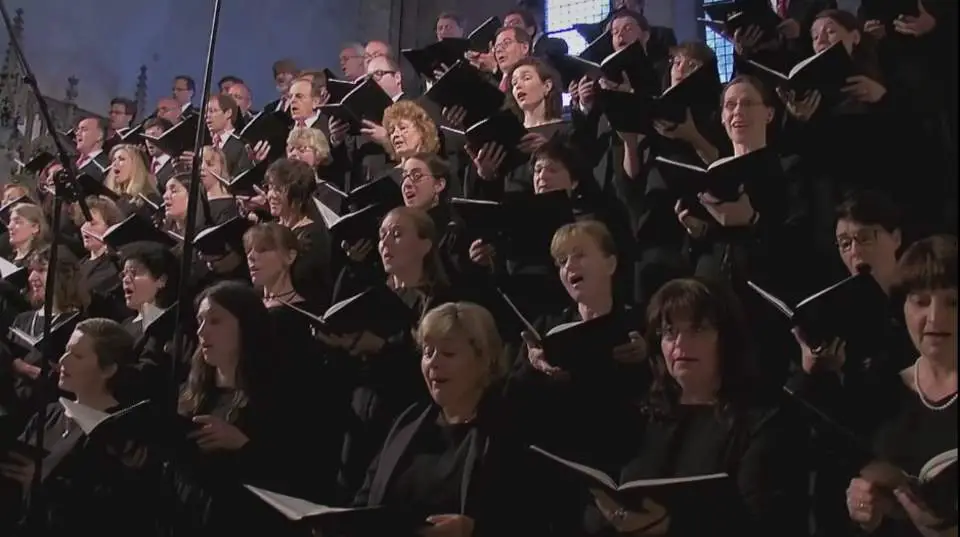Conducted by Andrés Orozco-Estrada, the hr-Sinfonieorchester (Frankfurt Radio Symphony Orchestra) and MDR Rundfunkchor (The Radio Choir of Leipzig, one of the oldest radio choirs in the world) perform Gioachino Rossini’s Stabat Mater, a musical work based on the traditional structure of the Stabat Mater for chorus and soloists. Recorded during the Rheingau Musik Festival 2015 on June 28, 2015, at the Kloster Eberbach (Eberbach Abbey). Soloists: Marina Rebeka, Soprano; Marina Comparato, Mezzo-soprano; Michele Angelini, Tenor; Marco Spotti, Bass.
Gioachino Rossini’s Stabat Mater
Structure
Rossini began the work in 1831 but did not complete it until 1841. It is scored for four vocal soloists (soprano, mezzo-soprano, tenor, and bass), a mixed chorus, and an orchestra of 2 flutes, 2 oboes, 2 clarinets, 2 bassoons, 4 horns, 2 trumpets, 3 trombones, timpani, and strings.
Gioachino Rossini’s “Stabat Mater” is a significant work in the choral-orchestral repertoire, reflecting a departure from his more frequently performed operatic compositions. It is a setting of the traditional Latin hymn Stabat Mater which meditates on the suffering of Mary, the mother of Jesus, during his crucifixion. The work is noted for its dramatic intensity, lyrical beauty, and operatic flair, blending Rossini’s mastery of operatic technique with sacred music traditions.
Each movement of “Stabat Mater” contributes to the overall narrative, ranging from somber reflection to exuberant praise:
- Stabat Mater dolorosa: The opening movement is a duet for chorus and two soloists. It sets the scene with a sorrowful, poignant melody, reflecting Mary’s grief at the foot of the cross.
- Cujus animam gementem: A tenor solo, this movement is known for its demanding vocal range and dramatic intensity. It features a soaring melody that conveys the depth of sorrow and compassion.
- Quis est h.: A duet for soprano and mezzo-soprano, this movement is a reflective piece, meditating on the shared suffering between Mary and the listener.
- Pro peccatis suae gentis: The bass solo in this movement is both solemn and powerful, reflecting on the theme of redemption and sacrifice.
- Eja, Mater, fons amoris: In this movement, the chorus and a bass soloist combine in a prayerful and contemplative piece, invoking Mary’s strength and love.
- Sancta Mater, istud agas: A quartet for soloists, this movement is a plea for Mary’s intercession, characterized by its lyrical and expressive melody.
- Fac ut portem Christi mortem: A duet for soprano and mezzo-soprano, this movement is a personal meditation on sharing in Christ’s suffering, marked by its tender and introspective quality.
- Inflammatus et accensus: This movement features a dramatic soprano solo, expressing a mix of fear and hope for salvation. It builds to a powerful climax, showcasing Rossini’s operatic sensibilities.
- Quando corpus morietur: A quartet for the soloists, this penultimate movement is subdued and somber, reflecting on death and the promise of eternal life.
- In sempiterna saecula. Amen: The final movement is an exuberant conclusion for the full chorus and orchestra, ending the work with a triumphant and uplifting affirmation of faith.
Rossini’s “Stabat Mater” is admired for its emotional range and the composer’s ability to convey deep religious sentiment through a blend of operatic style and sacred music tradition. Its dramatic contrasts, along with the rich interplay of solo and choral voices, make it a staple in the repertoire of choral works.
MDR Rundfunkchor

The MDR Radio Choir (German: MDR Rundfunkchor) was founded in 1946 as the “Rundfunkchor Leipzig” (“Leipzig Radio Choir”). Under the direction of the German Conductor Herbert Kegel (29 July 1920 – 20 November 1990), the choir developed in the 1950s and 1960s into one of the leading choirs in Europe.
Today the Rundfunkchor Leipzig is called MDR Rundfunkchor Leipzig.
Sources
- Stabat Mater (Rossini) on Wikipedia
- MDR Rundfunkchor official website